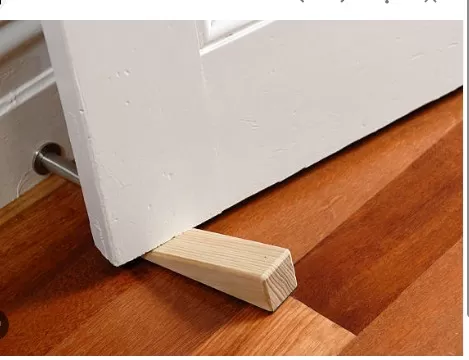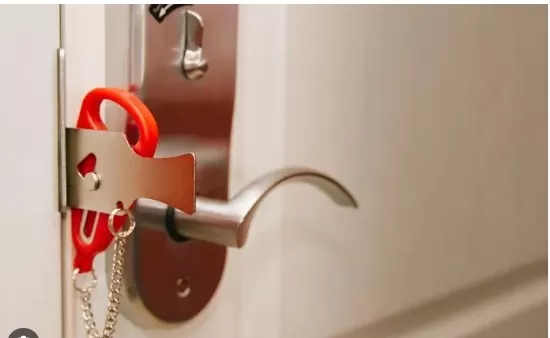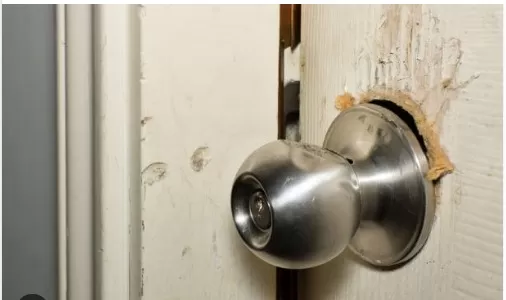Clever Door Security: 5 Creative Ways to Lock Without a Lock. If you find yourself in a situation where you need to secure apartment doors, bathroom doors, bedroom doors, or even entry doors without a permanent lock, there are temporary fixes that can provide some level of security. While they may not be as robust as permanent locks, these solutions can offer a measure of protection and peace of mind. Explore these options to secure your doors in a temporary and effective manner.
Enhancing Home Security: The Role of Doorstops

Doorstops serve a common purpose of preventing doors from closing, but they can also play a crucial role in home security.
While they are typically used to keep doors from shutting, when strategically placed behind inward-opening doors, doorstops physically impede the door from being opened, offering a reliable solution even if the doorknob is turned. This simple yet effective method can be particularly useful when the door lock is broken, providing an added layer of protection.
It’s important to note that doorstops are not suitable for outward-opening doors.
In such cases, alternative security measures should be considered to bolster your defenses. While doorstops can deter unauthorized entry, determined intruders may be able to bypass them with enough force.
Therefore, if you have an outward-opening door, it is advisable to explore additional security options mentioned in this guide to ensure comprehensive protection for your home.
Improvised Door Barricade: Utilizing the Back of a Chair
When seeking ways to secure a door using items readily available in your home, you may find a simple yet effective solution right in your dining room.
Sturdy chairs can serve as excellent door barricades due to their structural integrity. By positioning a chair strategically, you can create a robust barrier that prevents the door from opening.
To implement this method, angle the chair in a way that allows the top portion to wedge under the door handle while ensuring the chair’s feet are firmly planted on the ground.
This configuration generates pressure between the door and the floor along the back and legs of the chair, effectively impeding the door’s movement.
Moreover, the backrest of the chair can obstruct lever-style door handles from being depressed downward, further enhancing the barricade.
However, it is important to note that if the handle can also be turned upward to open the door, this method may not be as effective.
In such cases, it is recommended to secure the lever handle to the chair using a belt or rope, preventing it from being manipulated either downward or upward.
By firmly tying the handle to the chair, you can fortify the barricade and mitigate the risk of unauthorized entry.
Remember, while these improvised methods can provide temporary security, it is crucial to address any underlying door lock or security system issues for comprehensive, long-term home protection.
Enhancing Door Security with Belts or Ropes

When it comes to securing lever-style door handles, belts or ropes can serve as valuable tools due to their ability to restrict the physical movement of the handle.
By utilizing this method, you can effectively impede unauthorized access to a locked door.
To implement this technique, simply attach one end of the belt or rope to the lever handle and secure the other end to a fixed object, ensuring it is taut.
This restriction prevents the handle from being manipulated, bolstering the overall security of the door. In cases where the handle can be operated both upwards and downwards, using two tethers will provide complete immobilization.
Additionally, belts or ropes can be an excellent option for securing outward-opening doors.
By attaching the tether to a heavy object such as a refrigerator or couch, you can create a strong deterrent. This prevents the door from being forced open, significantly enhancing the security of your home.
For French doors, it is recommended to wrap both handles with the tether, effectively blocking their movement and minimizing the risk of unauthorized entry.
While belts or ropes can provide temporary security measures, it is important to address any underlying issues with the door lock or consider additional long-term security solutions for comprehensive protection.
Enhancing Security with Portable Door Locks
Portable door locks are valuable tools, especially for individuals who are renting or traveling and cannot install permanent security solutions.
Designed to be easily used and removed, these devices offer a convenient and temporary method to enhance door security.
A typical portable door lock consists of a metal piece, often called a claw, which is placed over the bolt or latch of the existing doorknob.
The lock component is then inserted into the claw, effectively preventing the door from opening unless the lock is disengaged. This simple yet effective mechanism provides an additional layer of security to reinforce the existing lock on the door.
However, it is essential to note that portable door locks are not suitable for outward-opening doors.
Their design and functionality are primarily intended for inward-opening doors, where the lock can secure the latch or bolt on the door frame. For outward-opening doors, alternative security measures should be considered to ensure comprehensive protection.
Whether you’re a renter or traveler, a portable door lock can offer peace of mind and an added sense of security.
Always remember to follow the manufacturer’s instructions when installing and using these devices for optimal effectiveness.
Enhancing Security with a Security Bar

When seeking enhanced protection against significant force, such as an intruder attempting to forcefully enter a door, security bars can be highly effective.
Designed to withstand considerable pressure, security bars or barricades offer a robust solution to reinforce door security.
Typically, a security bar consists of a pair of heavy-duty brackets that are securely fastened to either the wall or the door frame, depending on the specific product.
A thick metal or wooden bar is then placed within these brackets, effectively blocking the entire width of the door. This sturdy bar serves as a physical barrier, making it significantly more challenging for an intruder to kick down the door or force their way in with their shoulder.
The advantage of security bars is their ease of use.
When you need to use the door, the bar can be effortlessly lifted up and removed from the brackets, allowing normal access. Afterward, it can be quickly and easily replaced within the brackets for continued security.
It is important to note that security bars are not suitable for securing outward-opening doors.
Their design and functionality are primarily intended for inward-opening doors, where the bar can be positioned to block any attempts at forced entry.
By utilizing a security bar, you can significantly enhance the protection of your home and increase your peace of mind.
Remember to select a high-quality security bar and follow the manufacturer’s instructions for proper installation and usage.
Enhancing Security with a Security Bar.
When seeking enhanced protection against significant force, such as an intruder attempting to forcefully enter a door, security bars can be highly effective.
Designed to withstand considerable pressure, security bars or barricades offer a robust solution to reinforce door security.
Typically, a security bar consists of a pair of heavy-duty brackets that are securely fastened to either the wall or the door frame, depending on the specific product.
A thick metal or wooden bar is then placed within these brackets, effectively blocking the entire width of the door. This sturdy bar serves as a physical barrier, making it significantly more challenging for an intruder to kick down the door or force their way in with their shoulder.
The advantage of security bars is their ease of use.
When you need to use the door, the bar can be effortlessly lifted up and removed from the brackets, allowing normal access. Afterward, it can be quickly and easily replaced within the brackets for continued security.
It is important to note that security bars are not suitable for securing outward-opening doors.
Their design and functionality are primarily intended for inward-opening doors, where the bar can be positioned to block any attempts at forced entry.
By utilizing a security bar, you can significantly enhance the protection of your home and increase your peace of mind.
Remember to select a high-quality security bar and follow the manufacturer’s instructions for proper installation and usage.
*The information is for reference only.